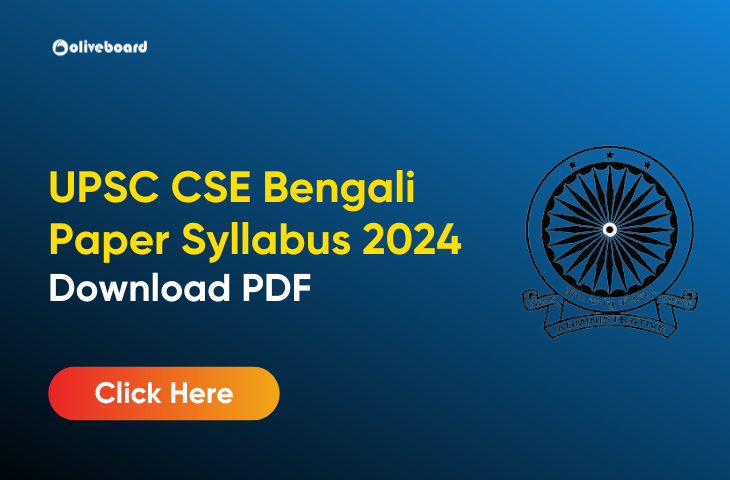UPSC Bengali Syllabus 2024
The UPSC Civil Services Exam allows Bengali as an optional subject in the Mains exam. The UPSC Bengali syllabus for UPSC 2024 covers Bengali literature’s history, prominent authors and their literary works, major poetry and prose styles, grammar, and the cultural backdrop of notable writings. The descriptive paper tests aspirants on comprehension, critical analysis, essay writing skills, and grasp of the subject matter through language, literature and contextual questions.
You can download the UPSC CSE Bengali Optional language paper syllabus from the direct link given below.
UPSC Bengali Syllabus 2024 Overview
The UPSC permits Bengali as an optional literature subject for the Civil Services Main Exam. As one of the 22 official Indian languages under the Eighth Schedule of the Constitution, Bengali has a rich literature and illustrious history of translations, original works and philosophy.
Bengali Language Syllabus for UPSC CSE 2024
Since Bengali literature requires expertise, candidates who have formally studied it or have Bengali as their native language should opt for this UPSC optional subject. Answers must be written in the Bengali script. The Bengali optional has two papers (Paper I and Paper II) in the UPSC Civil Services Main Exam, each carrying 250 marks making a total of 500 marks.
If you opt for Bengali language as optional in UPSC mains, prepare it thoroughly. Go through the UPSC CSE Syllabus and previous years’ Bengali papers.
UPSC CSE Bengali Syllabus 2024 for Paper 1
Section A: History of Bangla Language
- Chronological Track from Proto Indo-European to Bangla: Explore the evolution of the Bangla language from its Proto Indo-European roots, tracing its family tree with approximate dates and significant linguistic developments.
- Historical Stages of Bangla (Old, Middle, New) and their Linguistic Features: Analyze the linguistic characteristics of each historical stage of Bangla, including Old Bangla, Middle Bangla, and Modern Bangla, highlighting key features and evolutionary changes.
- Dialects of Bangla and their Distinguishing Characteristics: Discuss the various dialects of Bangla, including regional variations and their distinguishing linguistic features.
- Elements of Bangla Vocabulary: Examine the components of Bangla vocabulary, including loanwords, indigenous terms, and their semantic evolution over time.
- Forms of Bangla Literary Prose-Sadhu and Chalit: Compare and contrast Sadhu and Chalit forms of Bangla literary prose, focusing on their stylistic differences, usage, and historical significance.
- Processes of Language Change Relevant for Bangla: Explore linguistic processes such as Apinihiti, Abhishruti, Murdhanyibhavan, Nasikyibhavan, Samibhavan, Sadrishya, Svaragama, Svarasangati, y-shruti, and w-shruti, and their impact on the development of Bangla language.
- Problems of Standardization and Reform of Alphabet and Spelling: Discuss issues related to standardization and reform of the Bangla alphabet, spelling conventions, transliteration, and Romanization, considering historical and contemporary challenges.
- Phonology, Morphology, and Syntax of Modern Bangla: Analyze the phonological features, morphological structures, and basic syntactic patterns of Modern Bangla, including sounds, conjuncts, word formations, compounds, and sentence structures.
Section B: History of Bangla Literature
- Periodization of Bangla Literature: Old Bangla and Middle Bangla: Define the periods of Bangla literature, including Old Bangla and Middle Bangla, highlighting key characteristics, themes, and literary forms.
- Points of Difference between Modern and Pre-modern Bangla Literature: Identify the distinguishing features and thematic shifts between modern and pre-modern Bangla literature, considering socio-cultural contexts and literary movements.
- Roots and Reasons behind the Emergence of Modernity in Bangla Literature: Explore the historical and cultural factors that contributed to the emergence of modernity in Bangla literature, including influences from Western literary traditions and socio-political changes.
- Evolution of Various Middle Bangla Forms: Trace the development of Middle Bangla literary forms such as Mangal kavyas, Vaishnava lyrics, adapted narratives, and religious biographies, examining their thematic content and stylistic features.
- Secular Forms in Middle Bangla Literature: Discuss the emergence and evolution of secular themes and genres in Middle Bangla literature, including non-religious narratives, poetry, and prose.
- Narrative and Lyric Trends in Nineteenth Century Bangla Poetry: Analyze the narrative and lyric trends in nineteenth-century Bangla poetry, focusing on themes, poetic techniques, and major literary movements.
- Development of Prose in Bangla Literature: Examine the evolution of prose writing in Bangla literature, from its early forms to modern prose styles, considering the contributions of key authors and literary movements.
- Bangla Dramatic Literature (Nineteenth Century, Tagore, Post-1944 Bangla Drama): Discuss the evolution of Bangla dramatic literature, including nineteenth-century plays, the works of Rabindranath Tagore, and developments in Bangla drama post-1944.
- Tagore and Post-Tagoreans: Explore the literary contributions of Rabindranath Tagore and post-Tagorean authors to Bangla literature, considering their influence, themes, and stylistic innovations.
- Fiction, Major Authors (Bankimchandra, Tagore, Saratchandra, Bibhutibusan, Tarasankar, Manik): Analyze the works of major Bangla fiction authors, including Bankimchandra Chattopadhyay, Rabindranath Tagore, Saratchandra Chattopadhyay, Bibhutibhushan Bandopadhyay, Tarasankar Bandyopadhyay, and Manik Bandopadhyay, exploring their themes, narrative styles, and contributions to Bangla literature.
- Women and Bangla Literature: Creators and Created: Discuss the role and representation of women in Bangla literature, both as creators and as characters, examining gender dynamics, feminist perspectives, and the portrayal of female experiences in literary works.
UPSC CSE Bengali Syllabus 2024 for Paper 2
Section A: Bengali Literature
- Vaishnava Padavali (Calcutta University): Explore the devotional songs of the Vaishnava Padavali, focusing on their themes, literary style, and cultural significance in Bengali literature.
- Poems of Vidyapati, Chandidas, Jnanadas, Govindadas, and Balaramdas: Analyze the works of these prominent medieval Bengali poets, examining their poetic techniques, themes, and contributions to Bengali literature.
- Chandimangal Kalketu Episode by Mukunda (Sahitya Akademi): Discuss the Kalketu episode from Chandimangal by Mukunda, highlighting its narrative structure, thematic elements, and cultural context.
- Chaitanya Charitamrita Madya Lila by Krishnadas Kaviraj (Sahitya Akademi): Explore the Madya Lila section of Chaitanya Charitamrita by Krishnadas Kaviraj, focusing on its portrayal of the life and teachings of Chaitanya Mahaprabhu.
- Meghnadbadh Kavya by Madhusudan Dutta: Analyze Meghnadbadh Kavya by Madhusudan Dutta, examining its narrative style, poetic imagery, and thematic depth, particularly its retelling of the Ramayana from Meghnad’s perspective.
- Kapalkundala by Bankimchandra Chattarjee: Discuss Kapalkundala, a novel by Bankimchandra Chattopadhyay, exploring its plot, characters, and social themes, and its significance in Bengali literature.
- Samya and Bangadesher Krishak by Bankimchandra Chatterjee: Examine Samya and Bangadesher Krishak by Bankimchandra Chattopadhyay, focusing on their themes of social reform, nationalism, and rural life in Bengal.
- Sonar Tari by Rabindranath Tagore: Explore Sonar Tari, a literary work by Rabindranath Tagore, analyzing its themes, narrative structure, and its reflection of Tagore’s philosophical ideas.
- Chhinnapatravali by Rabindranath Tagore: Discuss Chhinnapatravali, a collection of writings by Rabindranath Tagore, examining its prose style, thematic content, and its significance in Bengali literature.
Section B: Modern Bengali Literature
- Raktakarabi by Rabindranath Tagore: Analyze Raktakarabi (Red Oleanders) by Rabindranath Tagore, focusing on its symbolism, social commentary, and its place in modern Bengali drama.
- Nabajatak by Rabindranath Tagore: Explore Nabajatak (The New Moon) by Rabindranath Tagore, examining its themes of renewal, hope, and spiritual awakening.
- Grihadaha by Saratchandra Chatterjee: Discuss Grihadaha (The Home in the World) by Saratchandra Chattopadhyay, analyzing its portrayal of social issues, family dynamics, and individual struggles.
- Prabandha Samgraha Vol. 1 by Pramatha Choudhuri: Examine Prabandha Samgraha Vol. 1 by Pramatha Choudhuri, focusing on its essays, literary criticism, and its role in shaping modern Bengali literary discourse.
- Aranyak by Bibhutibhushan Banerjee: Analyze Aranyak (The Forest) by Bibhutibhushan Bandopadhyay, exploring its depiction of nature, human relationships, and existential themes.
- Short Stories by Manik Bandyopadhyay: Discuss various short stories by Manik Bandyopadhyay, such as Atashi Mami, Pragaitihasik, Holud-Pora, Sarisrip, Haraner Natjamai, Chhoto-Bokulpurer Jatri, Kustharogir Bou, Jakey Ghush Ditey Hoy, examining their themes, narrative techniques, and social commentary.
- Shrestha Kavita by Jibanananda Das: Explore selected poems from Shrestha Kavita by Jibanananda Das, analyzing his poetic style, imagery, and existential themes.
- Jagori by Satinath Bhaduri: Discuss Jagori by Satinath Bhaduri, focusing on its portrayal of social issues, political activism, and its relevance in modern Bengali literature.
- Ebam Indrajit by Badal Sircar: Analyze Ebam Indrajit (And Indrajit) by Badal Sircar, examining its experimental style, existential themes, and its contribution to modern Bengali drama.
UPSC provides the detailed optional syllabus to assist candidates’ preparation. Completing the prescribed curriculum builds expertise to handle the Bengali optional paper in the CSE Mains exam for aspirants opting for this literature subject.
| Important Links | Important Links |
| UPSC CSE 2024 Apply Online | UPSC CSE 2024 Notification |
| UPSC CSE Eligibility Criteria | UPSC CSE Syllabus |
| UPSC CSE Exam Pattern | UPSC CSE Selection Process |
UPSC Bengali Syllabus 2024 FAQs
The UPSC Bengali syllabus for UPSC 2024 covers Bengali literature’s history, prominent authors and their literary works, major poetry and prose styles, grammar, and the cultural backdrop of notable writings. The descriptive paper tests aspirants on comprehension, critical analysis, essay writing skills, and grasp of the subject matter through language, literature and contextual questions.
Get Syllabus PDF here: Bengali Syllabus PDF
There is 250 marks is for one optional paper.

Hello, I’m Aditi the creative mind behind the words at Oliveboard. As a content writer specializing in state-level exams, my mission is to simplify complex exam information and help aspirants navigate their journey with clarity and confidence.
Having walked the path of an aspirant myself, I bring a unique, relatable perspective to my work. I focus on crafting accessible and accurate content on Exam Notifications, Admit Cards, and Results, ensuring candidates have the right information at the right time.
At Oliveboard, I play a key role in empowering students by breaking down the exam process into understandable and actionable insights. My aim is to make preparation less daunting and more rewarding, one well-informed step at a time.
